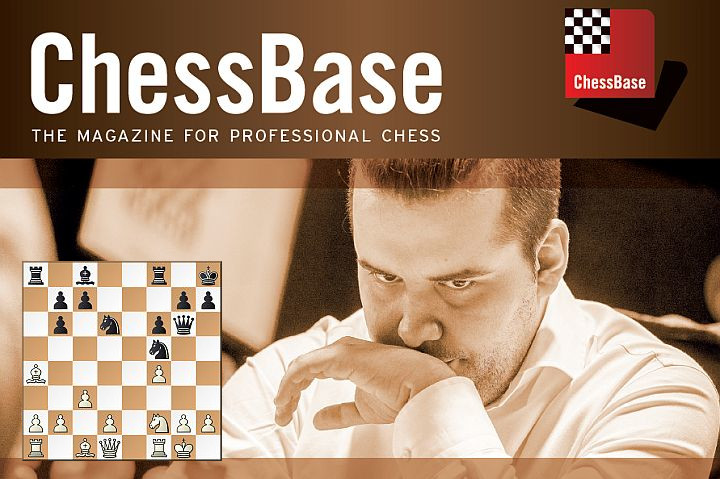


Jan Timman's chess career peaked in the early nineties, when he reached the final Candidates match twice in a row (1990, 1993). He had a wide repertoire and an enterprising and energetic style. This is in my opinion well illustrated by the following attractive attacking display from his top period, which won the best game prize in Linares 1992. One of the reasons he never made it to the absolute top was that most of the competition was at least a generation younger. This certainly goes for Nigel Short, who is 14 years his junior and one year after this game went on to beat Timman in a dramatic Candidates final (8 decisive games out of 13!).
1.e4 e5 Alekhine, Pirc, Caro-Kann, French and above all various Sicilians - Timman played it all... However, I was a bit surprised when Mega Database showed the text-move be his preferred reaction, albeit by only a small margin.
2.Nf3 Nc6 3.Nc3 Nigel has long been known to dabble with tactical and somewhat archaic open games (Evans Gambit and Two Knights with 4.Bg5 to name a few) and infuse them with new ideas. However, the Four Knights was not a surprising choice, as he played it more than once in his Candidates match against Speelman one year earlier.
3...Nf6 4.Bb5 Nd4 Timman decides to change tack - the text-move is one of many Rubinstein's contributions to opening theory, which have stood the test of time.
More often than not he played the symmetrical 4...Bb4 , but a year earlier he went on to lose this line against Kamsky, although this was hardly caused by the opening: 5.0–0 0–0 6.d3 d6 7.Bg5 Bxc3 8.bxc3 Qe7 9.Re1 Nd8 10.d4 Ne6 11.Bh4 Nf4 12.Nd2 Kh8 13.Bf1 h6 14.f3 g5 15.Bg3 Rg8 16.Nc4 Rg7 17.Ne3 h5 18.c4 Bd7 19.c3 Rag8 20.Nf5 Bxf5 21.exf5 h4 22.Bf2 Kamsky,G (2595)-Timman,J (2630) Tilburg 1991 22...c5
5.Ba4
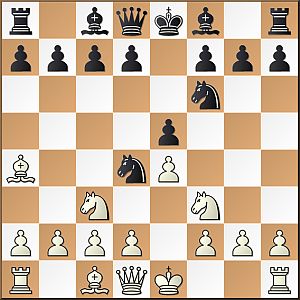
Statistically the most popular continuation.
The other main fighting reaction 5.Bc4 has also been heavily analysed.
5.Nxd4 exd4 6.e5 dxc3 7.exf6 Qxf6 8.dxc3 Qe5+ 9.Qe2 Qxe2+ 10.Bxe2= is usually a prelude to quick peace - Spasski and Timman split the point this way twice in the 1980s.;
5.Nxe5 is seen rarely nowadays, as 5...Qe7 6.f4 Nxb5 7.Nxb5 d6 8.Nf3 Qxe4+ 9.Kf2 Ng4+ 10.Kg3 Qg6 11.Nh4 Qf6! 12.h3 g5! 13.Qe2+ Ne5 14.Nf3 gxf4+ 15.Kh2 Kd8? can be better only for Black;
5.0–0 Nxb5 6.Nxb5 c6 7.Nc3 d6 8.d4 Qc7 9.Bg5 Be7 10.a4 h6 11.Bh4 Nh5 12.Bxe7 Qxe7 13.a5 Nf4 14.Ne2 Nxe2+ 15.Qxe2 0–0 16.Rfd1 Bg4 17.h3 Bxf3 18.Qxf3 Rad8 19.a6 b6 20.Ra3 exd4 21.Rxd4 Qe5 22.Rad3 c5 Carlsen,M (2862)-Dubov,D (2702) chess24.com rpd INT 2020
5...Bc5 Rubinstein's original continuation.
The intention of the knight's sortie is not an immediate swap, which furthers White's development: 5...Nxf3+ 6.Qxf3 c6 7.d3 d6 8.0–0 Be7 9.Nd5 0–0 10.Nxe7+ Qxe7 11.Bg5 h6 12.Bxf6 Qxf6 13.Qxf6 gxf6 14.f4 Bd7 15.Rf3 Rae8 16.Raf1 Kg7 17.Bb3 Be6 18.Rg3+ Kh7 19.fxe5 fxe5 20.Rf6 Bxb3 21.axb3 Re6 22.Rgf3 Rxf6 23.Rxf6 d5 24.Rd6 dxe4 25.dxe4 Huebner,R (2581)-Timman,J (2578) Potsdam 2012;
However, currently 5...c6!? is a fully-fledged and playable alternative:
6.Nxe5 The main move is the only principled alternative.
6...0–0 7.Nd3 "Don't place your minor pieces in front of your central pawns in the opening" is a sound axiom, but, as usual in chess, there are exceptions to every rule. The text-move removes the knight from an exposed square with tempo, White hopes to transfer the knight from d3 in the near future and develop his queenside forces.
Moreover, it has been proven best by test: 7.d3 d5 8.Bg5 c6 gives Black great compensation: 9.Qd2 Re8 10.f4 b5 11.Bb3 h6 12.Bh4 Nxe4 (The endgame is nice for Black, but even more energetic was 12...Qb6 or; 12...a5!? with excellent attacking chances.) 13.Bxd8 Nxd2 14.Kxd2 Rxd8 15.Ne2 Nxe2 16.Kxe2 Re8 17.Kf1 Bb7 18.c3 f6 19.Ng4 h5 20.Nf2 Be3 21.Bd1 h4 22.g3 a5 23.Bf3 b4 24.Kg2 bxc3 25.bxc3 Ba6 26.c4 Rad8 27.cxd5 cxd5 28.Rhd1 Re7 29.Ng4 hxg3 30.hxg3 Bd4 Tarrasch,S-Rubinstein,A San Sebastian 1912
7...Bb6 8.e5 "In open games, castle as soon as possible" is another maxim White should forget for a while here.
8.0–0?! d5 9.e5? (9.Nxd5 Nxd5 10.exd5 Qxd5 11.c3 Qe4 12.Nb4? Bh3!–+) 9...Bg4! 10.Qe1 Nh5 11.Nb4 Qh4 0–1, Bachmann,F-Hoffmann,H corr 1986 12.Nbxd5 Nf3+ 13.gxf3 Bxf3–+
8...Ne8 9.Nd5 Still following theory and his games against Speelman.
9.0–0 is still not ideal due to 9...d6 10.exd6 Nf6!? 11.d7!? (11.dxc7 Bxc7 12.f4 b5 13.Bb3 a5 14.Ne5 a4 15.Bxf7+ Rxf7 16.Nxf7 Kxf7 17.d3 Bg4–+ Silva,R-Putman,M email 2006) 11...Bxd7 12.Bxd7 Qxd7 13.Ne1 Rae8
9...d6 9...c6!? 10.Ne3 d5 11.0–0 f6 12.c3 Nf5 13.Bc2 Qe7 14.f4 Nxe3 15.dxe3 Bf5 16.a4 Bc7 17.b3 fxe5 18.Ba3 Bd6 19.Bxd6 Nxd6 20.Nxe5 Bxc2 21.Qxc2 Nf7 22.Ng4 h5 23.Nf2 Qxe3 Kasparov,G (2812)-Dominguez Perez,L (2739) Saint Louis blitz 2017
10.Ne3 In 1991 Nigel introduced this move into serious practice and it has been the main line ever since.
The prophylactic retreat is definitely more testing, than the previously played 10.c3 Qg5 11.Ne3 (11.cxd4 Qxg2 12.Ne7+ Kh8 13.Rf1 Bg4 14.f3 Bh3 15.Qe2 Qg5 16.Nd5 Marquardt,G (2206)-Marcinkiewicz,B (2174) email 2006 16...Bxd411...Nf5 gives Black excellent play. White still has no time for 10.0–0? dxe5 11.Nxb6 axb6
10...Qg5?!
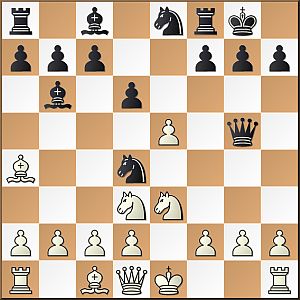
Timman freely admits the queen's sortie was not quite ideal.
Speelman's choice was 10...c6 and this still remains a playable alternative: 11.0–0 Bc7 12.c3 Ne6 13.f4 dxe5 14.Nxe5 Nxf4 15.d4 Bxe5 16.dxe5 Qxd1 17.Bxd1 Nd3 18.Nc4 Be6 19.Na5 Short,N (2635)-Speelman,J (2610) London 1991 Candidates/ Here D.King recommends 19...Nc7! , the position after 20.Be2 Nxc1 21.Raxc1 Rab8 (or 21...Nd5) is roughly equal. Especially in email games, Black has been doing well after 10...c5!? 11.c3 Nf5 12.exd6 Qxd6
11.f4 While objectively this is not a bad move, it does weaken White's setup, especially if he will subsequently release the central tension with exd6 (possibly exf6) - the further course of the game will provide ample proof.
11.exd6! is a simpler and better way to fight for an opening advantage: 11...Nxd6 12.0–0 N4f5 (12...Bf5 13.Ne1 Bg6 14.c3 N4f5 15.d4 c5 16.Nd5 Qd8 17.dxc5 Bxc5 18.Nd3 Ne4 19.Nxc5 Nxc5 20.Bc2 Re8 21.c4 Rc8 22.b3+–, Acs,P (2497)-Beliavsky,A (2654) Hungary 2001) 13.Ne1 Nxe3 14.fxe3 Bg4 15.Nf3 Qh5 16.h3 Bc8 17.d4 c6 18.c3 Bd7 19.Bc2 f5 20.Ne5 Huebner,R (2608)-Dervishi,E (2553) Palermo 2007
11...Qg6 The text is natural, but the engine prefers 11...Qh4+!? , forcing another weakening and giving Black reasonable compensation after 12.g3 Qh6 13.c3 Nf5? 14.Qf3 dxe5 15.Nxe5 Nxe3 16.dxe3 Nd6 Mansson,L-Johansson,C Ronneby 1998
12.0–0 f6 After 12...c6 13.Kh1 Nf5 14.Nxf5 Bxf5 15.Ne1!? the knight heads for f3 and Black must struggle to prove his compensation, as his pieces are also not ideally coordinated.
13.exd6?! Even from a strategic viewpoint, helping the reanimation of the passive Ne8 doesn't feel good. It's the first and quite serious step in the wrong direction. To offer an explanation, Nigel was definitely off form (he eventually shared last place) and even later on he missed more resilient options. White had two better continuations, which enable him to fight for an advantage:
13.Kh1!? is the safe choice: 13...c6 (13...fxe5 14.fxe5 Rxf1+ 15.Qxf1 dxe5 16.Nxe5 Qh5 was suggested by Timman, but White should retain an edge with 17.c3! Qxe5 18.cxd4 Qe7 19.Nd5 Qf7 20.Qxf7+ Kxf7 21.Bb3 Be6 22.Nxb6 axb6 23.d5. White should quickly do something for the development of his queenside forces - the right way to go is 14.b4! Nf5 15.Bb3+ Kh8 16.Qe1 Bd4 17.Bb2 Nxe3 18.dxe3 Bxb2 19.Nxb2 Bf5 20.Qd2 Be4 21.Nd3 b6 22.Rf2 h6 23.Rd1 Sax,G (2565)-Dreev,A (2590) Tilburg 1992. White has coordinated his forces and has a healthy extra pawn.
Engines get excited about the untested, but more direct 13.f5! Nxf5 14.Bb3+ Kh8 15.Nf4 Qh6 (15...Qg5 16.e6 is similar) 16.e6 c6 17.d4!? Bxd4 18.Qd3 suddenly changes the picture - now it's White with a lead in development and attacking chances compensating the pawn.
13...Nxd6 14.Nf2 The Nd3 finally leaves its outpost, preparing c3, but Timman is ready...
14...N4f5!
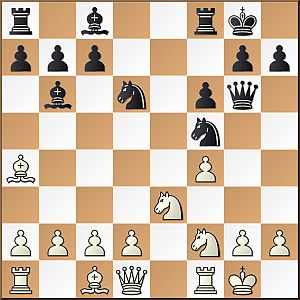
Now c3 won't be with tempo, Black is also toying with the idea Nh4.
15.Nd5? Nigel feels the pressure from the Bb6, but this ignores development just way too long.
15.c3 Nxe3 16.dxe3 Bf5 is pleasant for Black with easy moves to make (Rad8, c6, Rfe8), while White has difficulties deploying his Bc1 effectively.
The best, as indicated by Timman, was the modest 15.Qg4!? Qh6 16.Qd1. Black has a wide choice here. He can go for repetition with 16...Qg6= or seek compensation by various means, e.g., 16...Nxe3 17.dxe3 Be6; 16...Be6 or 16...c6 17.Bb3+ Kh8.
15...Kh8! Excellent prophylaxis - no forks on e7, no checks from b3.
16.Nxb6 Loses another tempo, but
16.Qf3 Nd4! 17.Qd1 N6f5 is also treacherous for White.
16...axb6 17.c3 Allows a direct tactical solution.

However, even the slightly more resilient 17.Bb3 most probably would have only prolonged the game, but hardly changed the outcome. After 17...Nd4 (Timman indicates the plausible alternative 17...Re8 18.c3 Nh4 19.g3 Ne4 20.Bc2 f5) 18.c3 Nxb3 19.Qxb3 Bd7 the glaring weakness of the light squares makes White's position untenable in the long run.
17...Rxa4! Even here the topic is an attack on the light squares - this sacrifice forcefully removes an important defender.
18.Qxa4 Nh4 19.g3 Nf3+ 20.Kg2 Nh4+ 21.Kg1 21.Kh1 Be6 22.d3 Bd5+ 23.Ne4 f5!?–+
21...Nf3+ 22.Kg2 Be6!–+
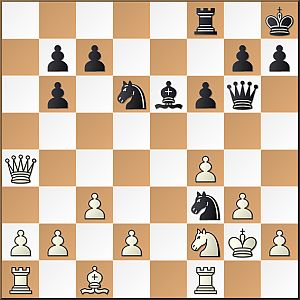
Elegantly actives the Bc8.
22...Qh5 23.h4 (23.d3 Re8! 24.Qd1 Re2! 25.Qxe2 Nh4+ 26.gxh4 Qxe2–+) 23...Qd5–+ was the more pedestrian alternative.
23.Nh1 Ugly, but other moves don't help either.
23.Kxf3 Bd5+ 24.Ke3 (24.Ke2 Re8+ 25.Kd1 Bf3#) 24...Re8+ 25.Kd4 c5+ 26.Kxd5 Qf7+ 27.Kxd6 Rd8+; 23.d3 Bd5 24.Ne4 Bc6 25.Qb4 f5 26.Nxd6 cxd6–+
23...Bd5 24.Rxf3 Nf5
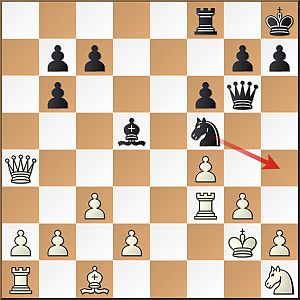
24...Qg4 25.Qd1 Nf5 26.Kf2 Re8–+
25.Nf2 Nh4+ 26.Kf1 Nxf3 27.d3 Nxh2+ 28.Ke2 Bc6 White has had enough - his exposed and lone king is attacked by 4 fully coordinated black pieces.
0–1
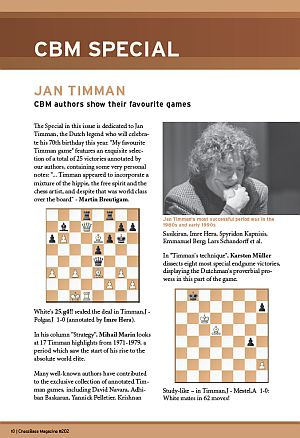
You can find the full and much more detailed analysis by Igor Stohl in ChessBase Magazine #202!
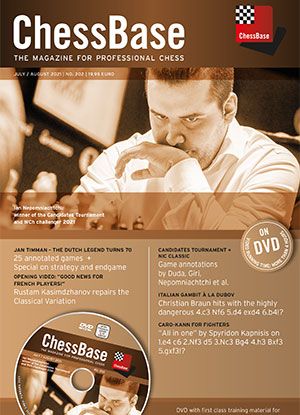
Take your chance and train with the experts from ChessBase Magazine. Take your chess to a new level with the help of many renowned authors!
All subscription offers and further information can be found on the ChessBase Magazine homepage.